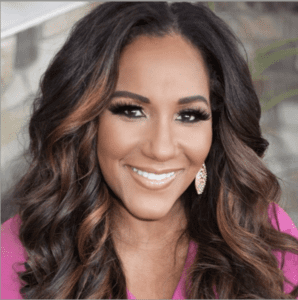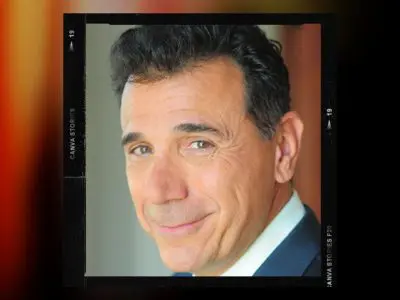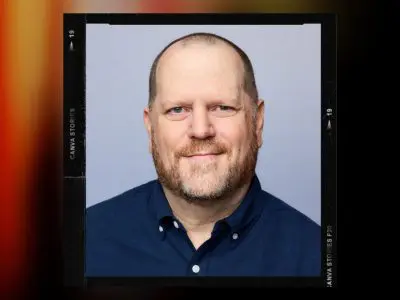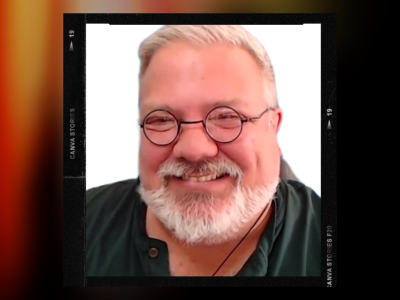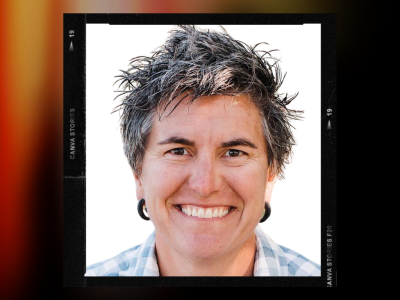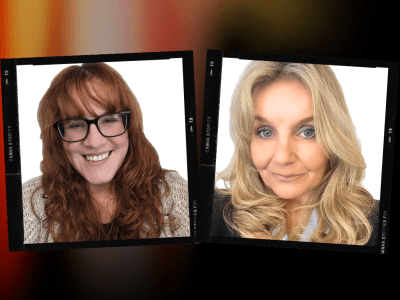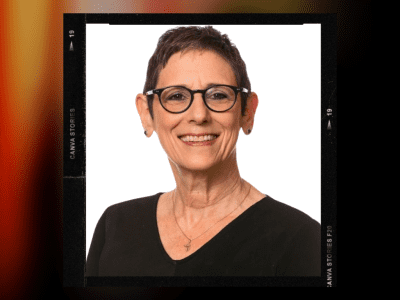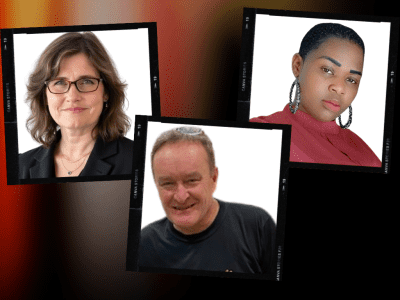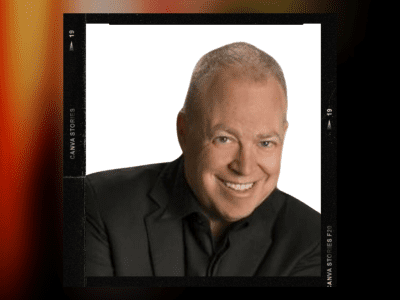Navigating Taboo Conversation Topics at Work
w/Karith Foster
Use the buttons above to listen now.
Transcript - Navigating Taboo Conversation Topics at Work
Rich: On this episode of Team Building Saves the World,
Karith: there’s apparently over a hundred different types of implicit biases that have been identified. Mm. Oftentimes we’re told, well, it’s business. You can’t make it personal. It’s not personal. Right. Well, you can’t not make it personal. There’s no getting around it.
Now, that doesn’t mean it has to turn into a therapy session. We solve the problem. Everything is awesome. No, no. I have yet to meet anybody except for Prince Harry, who’s, you know, and even he’s got some troubles.
Rich: Okay. He wouldn’t have, he wouldn’t have written a book.
Karith: Right. I mean, come on.
Rich: Hello team. It’s me, your old friend Rich Rininisland host of team building Saves the world, a show where I speak to thought leaders from around the world discussing variable strategies and tools to help you and your team build a better work environment. And today we’re talking about taboo topics with a professional comedian, public speaker, radio personality and creator of in Inversity Karith Foster.
But first I need to share some love with the rest of my. As a team bonding. If your team is ready to experience teamwork for the power of play, then visit team bonding.com to learn more. Now teams join me in welcoming my guest. The author of You Can Be Perfect or You can be Happy. Karith Foster.
Hello, Karith thank
Karith: you for having me, rich.
Rich: Thank you Karith. Thank you very, very much. So I wanna start off by telling my audience a little bit about you. and how you got involved in this industry.
Karith: Absolutely. So, you know, you kind of nailed in the intro. I, I jokingly say I’m a recovered journalist. That’s what I got my degree in.
I moved to New York City after working at a local a b C affiliate. I moved to work for national tv. Mm. Barbara Walters was my first boss. I Wow. Worked for the view. . Okay. Bless her soul. Um, and I, while I was there, I found standup comedy, or rather it found me. And I realized that that was really the space where I could be authentic.
I could be myself, I could use my voice and I could tell the truth. Not that you don’t get to tell the truth in media, but you get to tell different versions of the truth. Right. Like after did the sponsors allow and the networks and so forth, . But I always, my goal. , every iteration of my career has been to bring people together, to bring, to connect them.
And while I was pursuing standup by day, by night, I was a, excuse me. I was pursuing standup by night. I worked in human resources for a Fortune 500 cosmetics company. Hmm. Uh, in New York City. And so, again, you know, everything just had to do with how, how can I help people? How can I, you know, enlighten people, educate them.
And I just left that position. When I got a call saying, Hey Karith you interested in a radio TV opportunity? And I said, uh, of course what? You know, comedian worth, their salt isn’t . And they said, by the way, it’s with Don Imus. And I said, nap headed host Don Imus , because that’s was the quote heard around the world.
Yeah. That got him fired. Yep. And so I was asked to come on and be a co-host on his show to have a national dialogue about racism and America. And I remember being terrified because it’s like, this is my reputation on the line. Do I join forces with one of the most reviled men in media? , or do I use this as an opportunity to be a voice where there was a deficit?
And so I, I, I said yes, and I was there for two of the three years of my contract. But what it, it led me to discover was what are the conversations happening around diversity and inclusion, not just like in the workforce, but on college campuses. And of course, college campuses matriculate into the workforce.
So like, how, what is happening and why have we been doing this for so many decades now? and things don’t seem to be getting better. Right. In fact, they seem getting worse.
Rich: And tell us about inversity. Is this how you came to found inversity?
Karith: It is. It is. That was the catalyst for inversity because through my really deep dive into, you know, the different types of programs and unconscious bias trainings and this, that, and the other, I realized, wait a second.
we’re doing the same thing over and over again, and it’s not getting better. Isn’t that the definition of insanity? Yeah. What needs to change? And what I realized was it wasn’t that the message was bad, it was how the message was being delivered. Like, yes, we should celebrate and be aware and respect other people’s cultures and their identities and who they are.
But if the approach is gonna be to further divide us, really is the prefix of the word diversity, right? Div v. Divide, like we’re shocked it’s not working right. Let’s, let’s just put a twist in there. Let’s still acknowledge, honor, respect, who we are, what we bring to the table, our backgrounds, our heritages, everything you know about our identity.
But let’s shift the focus from what separates and divides to what do we have in common? How can we be truly inclusive, but most importantly and, and powerfully, how can we be introspective, right? Meaning, understanding your value in worth so you can then see it in someone. So we’ve been working from the outside in for decades now.
Now we gotta work from the inside out cuz that’s where real change happens, right? You can’t, you can lecture somebody till they’re blue in the face or you are blue in the face. Everybody’s blue in the face. . But if you’re not reaching their heart, if you’re not making it personal, if you’re not connecting them to the experience, nothing’s gonna change.
And in fact, what it can create is a lot of resistance, a lot of resentment, right? Especially if it’s being done in a way of you’re a victim because of who you are and how you’re seen in the world. Or you’re a villain because of who you are and how you’re seeing in the world. And it’s not fair. It robs people of their agency and it’s not really shocking why it hasn’t been working.
Rich: So give us some examples. What are some of these topics that people just really either have not correctly been talking about or can’t even begin to discuss?
Karith: Sure. I think one of the biggest mistakes people make when they’re talking about bringing in like diversity, d e I, diversity, inclusion belonging programming, is they think it’s a two-way street and one of the lanes is that the end result is that everybody’s gonna get along afterwards and see everything the exact same way.
and quite honestly, isn’t that the antithesis of true diversity? Yeah. It’s not to have everybody thinking the same way. It’s to create a culture of respect and value, but we’re supposed to have diverse thoughts, ideas, experiences. That’s what makes it a special environment to be in because you’re getting those influences from people who have different.
That I think people get caught up in is thinking that diversity is just about someone’s ethnicity or you know, some people say race. I don’t say that because there’s only one race, a human race. Like that’s the reality, right? Sure. But that’s the, the term that’s used, ethnicity slash race, gender, and sexuality.
Real diversity is again, diversity of thought ideas, neurodiversity, right? People’s socioeconomic status, their backgrounds, you know, their political views. Like it’s so much, yeah. That really encompasses what true diversity is. Yet, when the focus is only what your skin color is, which bathroom you use, you know, we’re bound to really run into trouble.
Rich: So where can this begin? Uh, how do we start having these conversations? I mean, let us say that I’m somebody who has hired you in because I don’t even know how to begin having these conversations with my people.
Karith: That’s where a lot of people are, quite honestly. Hmm. Um, I find that a lot of the work that I do is.
Corrective and protective. Right. Okay. Corrective because they’ve had somebody come in, do DEI work, and it’s gone terribly wrong. Like it took a left turn. Okay. Because again, they just were following the two lanes that they think it’s supposed to be. Right. It’s not a two-lane street. It’s a six-lane highway.
Okay. It’s protective. When there are people who are like saying what you just said, I want to have. an inclusive environment. I want to have an environment of belonging that celebrates diversity. . But I wanna do it well. I wanna do it thoughtfully and compassionately. And I say, you found the right person, because that’s what I do.
And I think I set the stage by first sharing what inversity really is about what our goals are within inversity. And as I stated earlier, it’s not about creating enemies of one another, it’s not about creating victims. Mm-hmm. of one another. It’s understanding that yes, we have had different experiences without question.
Yes, the way our world works and society puts us in these categories and labels us, it sucks. It’s not fair, right? But guess what? We have the power to defy those labels. We have the power to say, you know what? I’m not gonna subscribe to that narrative. And we have the power to understand that we are human beings having a human experience.
And while it may not be exactly what someone else is, if we can invoke what I call the care methodology, right? four things. Conscious empathy. Learn how to be active listeners. React responsibly, right? Yeah. Respond in a way that doesn’t act as a catalyst for a powder keg, right? Right. If we can figure out how to communicate in a really healthy way, where we can disarm people, where we can, you know, process things before jumping the gun and making assumptions where we can have healthy.
Conscious communication, we’re, we’re there. And the E and care is environmental awareness because all of this has to start with being aware, aware of the fact that we all have biases, every single one of us. And the idea isn’t to wag the finger in the face, oh, you’re a terrible person, you need a timeout.
It’s understanding a, what was that bias that came up for me? And by the way, there’s apparently over a hundred. , different types of implicit biases that have been identified. , the most popular witch is affinity bias. Right. I’ll call it the birds of a feather. Bias, right? Because we are attracted to people who are like us.
Rich: Yeah.
Karith: Who sound like us, maybe, who look like us, who went to the same school as us, or from the same part of the world as us. Right? That’s natural. That’s not a bad thing. It’s just understanding when that’s coming into play and that’s keeping you from missing out on an opportunity and experience a relationship.
Rich: Let’s go back just a little bit again, going with that. I’m somebody who wants to hire you to bring you in. Even before that, what should I be looking for within my organization, within my subordinates, let’s say to know that I need someone like you.
Karith: Okay. Well, I think as a leader you have to ask, why am I doing this?
What is my why? Am I doing this because I wanna look good? Right? Not just for my employees. Right. But for our customers, like are the optics something that I care about a lot? Mm-hmm. Which we saw a lot of that happen after 2020. And George Floyd and a lot of companies like, oh, we gotta, we gotta hire Chief Diversity Officer, now we gotta get some affinity groups.
We gotta, we gotta do something. Right. But were they sincere in that or was it, we gotta catch up. Because otherwise we look bad. Hmm. Are you a leader who says, you know what? I wanna create a healthy culture where people feel like they belong and they’re included Because I understand that when that is a factor.
retention is higher. You, so much of this is really numbers. It’s a numbers game. Like yes, it’s personal because there’s no way you can have a conversation around diversity and inclusion and it not be personal, cuz we’re talking about who we are and what we bring to the table, right? But the reality is, if you are not making sure that you have a healthy culture, you’re gonna be losing money left and right because it costs money to replace people.
It costs money to hire people. It costs money to recruit, right? It costs money to have these trainings over and over and over again and nothing’s changing. Nothing’s shifting. It costs hours of HR when there are complaints, when there are issues. So where, what is your why for doing this, for having these types of programs come in?
Is it to check the box or is it because you sincerely wish to make a statement? and create a culture from the top down, and it has to be from the top down. It has to be, you have to lead by example. One of my favorite books is Atomic Habits, and I think a lot of people make the mistake also of thinking, well, okay, diversity is a big topic right now.
It’s a big issue. Let’s just bring somebody in and and have a keynote and then we solve the problem. Everything is awesome. No, no. It has to be these small micro things because there are a lot of people right now, as I mentioned, Corrective phase. Who have they? They have diversity. P T S D. Mm. They have d ei, P T S D because they’ve either been made the example right of the, the, the token marginalized person and they’ve had to share their story over and over again, which is exhausting.
Or they’ve been, you know, had put their head put on a pitchfork because you’re a straight white guy and you’re never gonna get it. You’re never gonna understand you’re evil just for being you. Like that does not work. Right. , right. So if you can find a way, and this is what I teach, how do you integrate these lessons that aren’t it?
I hate that it’s even under the umbrella of diversity. Because it’s really learning and development. It’s really communication, it’s really compassion and empathy. And yes, they translate into diversity, but I think we need to maybe even step away from it being under that umbrella per.
Rich: How do we teach that though?
How do you even begin to try to, because you’re talking about people who are anywhere from 20 years old to fifties and sixties. How do you teach them empathy? Because I have yet to hear anyone, as many times as that has come up as the overall success rate of you want to be, you wanna be a successful business, you want to be a success with other people surrounding you.
You need to learn to be empathic. How do we.
Karith: what’s, you make it personal. You have to make it personal. And you know, I, I mentioned that I’m a former standup comedian. I actually just headlined a show for a town, but I, I try to, it’s like the mafia, right? You try to leave and it pulls you back in . Um, but you, one of the gifts that I received from doing standup for so long, you know, working from Washington state to Washington, DC is becoming a master communicator, and within that is learning how to speak to people where they are not talking over their heads, not speaking down to them.
Um, because the number one rule in comedy yet, be funny, but it’s not your audience. Right? And I think a lot of people who do this work, they, they just go in with their stats and their figures and their metrics and their, this is how you should do it, and this is how you should behave, and this is what you should say, and this is what you shouldn’t say without reaching people where they are, without talking to them, without hearing them, and without getting them to understand how you can be compassionate, how you can grow your empathy.
And that. That’s it. It, it means being vulnerable and that also is what standup comedians are. We’re not, if nothing else, we, it is the most vulnerable art form in the world because it is all you for complete acceptance or complete rejection. Trying to get people complete strangers to laugh at something that you think is funny too.
But in that, Realm of being a master communicator. It’s learning how to convey an idea, a thought, a notion, a concept. Mm. So that everyone gets it. And that’s how you teach empathy. You have to reach people, you have to be empathetic yourself, right? Truly to be able to teach other people how to do it. Now, am I perfect?
Absolutely not. Do I have issues? Do I have like times of buy? Without question? Without question. And so, you know, I have these, these, these moments, I call them empathetic insights, right? Or empathy insights. Like will you just try to catch yourself during the day? You know, perfect example. I had to leave for new, a flight to New York couple months ago.
and my younger daughter was coming with me. My older daughter and husband were coming later. Mm. And it was no o’clock in the morning. We had a six o’clock flight. The car was coming to get us at four. And she is a night owl. And while she’s a little string bean, you know when a child is knocked out, it’s dead weight.
Yeah, right. I mean it’s like, and I remember trying to dress her at four in the morning going, and I have, I had an empathy insight. I thought, oh my God. , this is what parents have to do if children who are incapacitated mm-hmm. children who may be really high in the, you know, autism spectrum level. Right.
Like I, I just thought about how many people like this is their daily. Practice and they still get up and they still go to work and they still like, first of all, I was, how blessed am I? But it was like, oh my God, I never thought about it, that other people will have to do this too. That’s what teaching empathy is about.
Not living it all the time, but having those moments so that when it does come up, For someone else, even though it’s not your life, you, you, you have that insight, you have that compassion.
Rich: And, uh, I wanna get further into this. I wanna dig a little bit deeper and see some work experiences that you’ve gone through, but I need you to stand by for me for just one moment, if you may, because I need to take a second here and talk about a company.
I am very proud to be a part of Team Bonding. Team Bonding was founded over 20 years ago with one simple question. How can employees have a great time while fostering strong authentic bonds between people who work together? No matter where your company is located? Team Bonding offers powerful, engaging, custom team building events designed to get the best out of your team anywhere in the world.
They’ve created a catalog of innovative events using the power of play as a learning tool and tapping into the correlation of work and play. From scavenger hunt to jeopardy and so much more, the team bonding of activities, be it live, virtual or hybrid, maximizes the impact of team building with an accent on fun.
So visit team bonding.com to schedule your event now. Team bonding when you want. Seriously. Fun results. And we are back talking about taboo topics with Karith. Um, let’s go ahead, let’s keep going with, uh, more examples. Can, can just give us just from your own experiences, things that you have actually seen or had to help manage without, you know, of course getting into, getting into specific names.
Karith: No, no, no, no, no. That I, I, that’s so. . I I love the plug that you just gave because I think that is a very poignant point that you made when you can make it fun. Yeah. Right. When you can make it not a daunting, not a, a, a threatening experience, which I think is what a lot of people feel when they go into diversity type scenarios.
Trainings programs. Um, very few people get excited these days when they hear they’re gonna have a diversity speaker come in . And it’s like, that’s horrible. Like, . I like to leave my audiences feeling engaged, inspired, connected, because that should be the ultimate goal. Again, you know, nobody should leave wanting to, you know, self flag and, and right.
Be shamed and, and hurt. Like that’s the antithesis of how you teach people to grow. You know, it’s like training a child or a puppy. Like people don’t learn from being yelled at. They learn from being encouraged. You know, one of the things that I like to say, , you have to call people in, not call them out.
Okay. And I get that calling out is a big thing cuz Well, if we don’t call people out, how are they gonna know that they’re wrong?
Rich: Right, right, right.
Karith: Call. Guess what, if people don’t, we don’t know what we don’t know. Right? So this is where, and I use a lot of words that aren’t very popular yet in corporate America, but like grace.
Like having grace, not just with other people, but with yourselves. We are learning. I mean, the world of diversity is constantly shifting and changing because guess what? There’s always a new. Word to use. There’s always a new term. There’s always something that, oh, well, that means this now. So you can’t say like, people are trying to catch up and it’s moving a hundred miles a minute.
And so we have to have grace with the people who aren’t there yet, right? We have to have grace with ourselves, you know, if we screw up and allowing people to be human. And when I say that, you know, I, I wrote a book called, you Can Be Perfect or you can be Happy. Mm-hmm. Spoiler alert, there’s no such thing as perfect
Rich: Is there such a thing as happy ?
Karith: Happiness is a choice, but here’s, here’s the thing. This is a caveat, well, it as, as happiness is as individual as we are. The choice of happiness means that it’s something you can do for yourself. Now, it’s not constant. And I think that’s another mistake that we make. Oh, we have to be on all the time we have.
Life is good. I have to have a smile on my face. Things are hard. We have stress in our lives on a regular basis, like I think it is perfectly okay and normal to not wanna get outta bed for a day, or even a weekend, three weeks, you should go talk to someone , right? But if we could have grace with ourselves in these conversations that are not easy because when you are faced with a topic, that is foreign to you, whatever it is.
Whether you’re somebody who is fully abled and you’re talking to someone who has a disability, right? Right. It can be uncomfortable whether you are a person of color who’s talking to someone who is not, and they’ve never experienced some of the things that you’ve experienced. It can be uncomfortable.
. But here’s the reality. Reality. We all know what it feels like to not be included . We all know what it feels like to be ignored, to be dismissed, to be rejected. We also know what it feels like to be included, to feel like we’re part of something, to be encouraged, to be supported. And that’s the universal aspect that we need to apply and make it personal.
You know, I think oftentimes we’re told, well, it’s business. You can’t make it personal. It’s not personal, right? Well, you can’t not make it personal. There’s no getting around it. Now, that doesn’t mean it has to turn into a therapy session. , right? Because it is, you need to keep it professional. It’s a business.
Things need to get done, right. But if you can create a space where you teach people how to have healthy conversations, which is what I do more than anything, then you can create an environment where the conflicts, if they do come up, they don’t escalate, they don’t turn. It doesn’t turn into a powder keg.
And again, understanding that the end goal isn’t agreeing. .It doesn’t, it’s not supposed to be agreement, but it’s supposed to be understanding.
Rich: Mm-hmm. Yeah.
Karith: And respect. And, and I’ll often, I’ll use that, you remember that dress that went viral years ago and some people saw it as blue and black.
Rich: Yes. Yes.
Karith: And some people saw it as white and gold.
Right. And I’ll, I’ll use that as a really fun example. And do you even know the backstory behind that dress? ?
Rich: I don’t, no.
Karith: Okay. I’m gonna, I’m gonna, okay. A woman in England was buying that dress for her daughter’s wedding, and she wasn’t sure, so she took a picture and texted it to several of her friends.
And some friends were like, oh, this is brilliant. We love it. And some people were appalled. They were like, I can’t believe you would even think to wear white to your own daughter’s wedding .
And she’s like, what are you talking about? And that’s how it got started. Right. Now we know scientifically there’s a reason why people saw it a certain way.
It has to do with how your eyes taken light and the cones and the, all that good stuff. Right? But I, I, I love that as an example of why people got so upset about it. Because everybody who saw it, first of all, thought they were right. . I’m looking at it with my own two eyes. Are you messing with me?
Is there something wrong with me? . You know what I mean? Like we go into this, like, what’s happening here? But think about how often we see a scenario. Same thing, but because we have different perspectives, it’s, it’s. , different. Kneeling at a football game versus dishonoring our service men and women.
Rich: Mm-hmm.
Karith: Right. Yeah. Like how often does this come up? Especially in conversations around diversity and inclusion where because we have a very different perspective, we are seeing it completely differently, so that’s why we have to figure out how to talk to one another to work through it. Now, that doesn’t mean we’re gonna see it the exact same way, but at least we have the opportunity to hear what someone else’s perspective is so we can understand them and their experience a little better.
Rich: Speaking of which, talking about the different perspectives, I mean there are now five different generations existing within the workplace. Talk about your different perspectives. What have you seen first off, uh, between the different generations that right now, and how do you get the greatest generation to talk to the millennials and have everyone speaking with an heir of empathy?
Karith: It’s a challenge.
Rich: Sure.
Karith: No lie. It is a challenge because we’re basically talking about people who speak different languages.
Rich: Right, right, right.
Karith: We’re thinking, we’re talking about people who have automatically dismissed one another, whether it’s because they’re so young and they don’t know anything.
Mm-hmm. Or because they’re so old and they’re just outdated and they’re not relevant and flexible. Yeah. Yeah. Right, right. And so the idea is to, again, create a space, and this is why I use humor because. . It’s the great neutralizer. When you are laughing, you, you can’t be, you, you can’t frown when you are laughing certain.
I, I almost feel like it’s kinda like the Trojan horse, right? Like, I have a secret recipe. I’m the unicorn, the endorphins that are kicking off the physiological effects that it has on the brain and the way that it. , it takes people who are normally on the offensive or the defensive. It, it lets those gates down just for a little bit and that’s when you have the opportunity to have the epiphanies and the aha moments.
And I have had multiple sessions like, so one of my favorite sessions ever, same session. Okay. And I had an older. , well not older, like middle-aged, very militant black lesbian come up to me and say, Karith, I am so glad that you came here and you said what you had to say and these people needed to hear it and it was amazing and duh.
And then I had this like millennial white guy, like Lily White from Utah come up and say, Ms. Foster, this was the first time I ever felt included in a conversation about diversity.
Rich: Very good.
Karith: Same session. So I’m like, I know what I’m doing works. And again, the idea is to reach people where they are, to not exclude people, to not embarrass or shame people or put people on a pedestal or bury them under the ground because it’s about creating understanding.
And I think because this has been in effect for so long, these D N I conversations, , people are tired, but they also think like, , we just need more of it. Right? Like it’s not working cuz we just need, we just need to do more of it. We just need to pound it harder. And it’s like, do you understand that that’s like yelling louder at a deaf person?
Rich: Yeah. Yeah.
Karith: You’re not changing how you do it. Like it’s a, it’s insulting, and B it’s not working, so we gotta, we gotta make a shift. And I’m shocked that there aren’t more people doing it, but it’s like, I think some people think if it ain’t broke, don’t fix it. But it is broke. , it clearly is broken, so I can’t wrap my head around why people are still doing it the same way.
Rich: What does that look like? What does a poorly done diversity and inclusion conversation look like?
Karith: For example, there are certain exercises that people will do where they, they, they separate people into groups. Again, based on Oh, your gender, your ethnicity. Yeah. Your, you know, and, and, and this is my favorite.
They use the term privilege. Now. Yeah. We understand what that word means. Yeah. However, the interpretation for many people is you’re automatically given everything born with a silver spoon in your mouth. You’ve never had any obstacles, no problems. Your life is golden. I have yet to meet anybody except for Prince Harry, who’s, you know, and even he’s got some troubles,
Okay.
Rich: He wouldn’t have, he wouldn’t have written.
Karith: Right. . I mean, come on. So I think the language, right? The la Now listen, most of the people listening to this right now have privilege. Okay? You have access to the internet, you have privilege.
Rich: Sure.
Karith: If you are literate, you have, if you are a woman and you have access to sanitary supplies, you are privileged.
Okay? More, you have more than most of the world if you’ve clean water. There are people in America who don’t even have clean water. Yeah. Hello? Flint, Michigan.
Rich: Yeah. Okay. Yeah.
Karith: Right. That’s privilege. Mm-hmm. . . There are advantages, and I think using that term, not that it’s about softening the globe, but it’s about getting people understand that there are many things that can be an advantage.
Sure. Your ethnicity and skin color can be an advantage. Your height can be an advantage. Your level of attractiveness is an advantage. How much money you have in your bank account, the kind of family you came from, the school you went to, that most definitely is an advantage. And so the idea behind it is to understand.
Do I have advantage? Is that something that I can understand, not feel guilty about? Cuz I had nothing to do with it, right? Most of the time. But how do I then act as an advocate? for someone who doesn’t have the same advantages. Mm-hmm. , how can I stand up and be there? And the term ally, right. I think Ally’s a great word, except again, that’s another word that’s been a little distorted.
It makes people think, well, I have to give up my belief system and support somebody else who I not, I don’t. Maybe their lifestyle isn’t what I approve of or, right. Right. , but that, that’s being an advocate doesn’t mean that like, and I think again, that’s another, I’m so on this track, this isn’t about belief systems.
this is about behavior.
Rich: Yeah, yeah, yeah. Good, good. Yeah. Cause I was gonna ask, I mean, how do you teach people that their advantages that they have aren’t a right, that they have, that they didn’t earn these advantages? Cuz that’s not what you’re talking about
Karith: Exactly. But it’s not being preached that way In traditional D N I work.
Rich: Well, we know, I mean, for, for however long you come in and you’re involved in a corporation, the work must continue after you. How do we do that? So you’ve come in and you’ve had your, you, you’ve had your training session with people. How do we help to make sure that they’re continuing down the right path and don’t either fall back into old habits or pick up new bad.
Karith: Well, that’s why what I do is not one and done everything I can do in my power to keep it from being a one and done. Yeah, I do. Okay. And I have a curriculum, um, right now that’s seven modules that, um, has discussion guides that offer support for entire companies and organizations. I, um, consult with people who are in people lead positions, whether it is the chief diversity officer or it is the chief people officer.
You know, however they, the company has it structured so that they don’t feel like they, like, this was great. Now what? That’s where so much of this falls short. The now what? Well, I, I give people the, now what I give them programs and ideas and different exercises to do throughout, because again, it’s like the atomic habits, right?
It’s it atomic inversity , you gotta, it’s gotta be a daily practice. They don’t call it yoga. Perfect. They call it yoga practice . And that’s what this. And you’re gonna have ups and downs. You’re gonna have highs and lows. But the idea is not to get to a place where your business is in the news because of such a, a horrific, you know, downfall of outbreak of, of, of just massive low morale of an incident that got out of control that you weren’t able to handle like a lot of people do
d e I work as a, a bandaid. Sometimes it’s triage. Yeah. I wanna be the probiotic. , okay. I wanna be the vitamin B shot. I wanna help keep you healthy. I wanna keep you from getting sick. And you take that and you incorporate the, the philosophy and methodology of inversity to create an inclusive culture of belonging.
Mm-hmm. . And then you are set for the duration of your company if you follow the practices.
Rich: What are you hoping for for the future?
Karith: When it comes to I’m hoping to be outta work, I’m hoping that this isn’t an evergreen business. I swear to God. Like I just, like, I’ll come in, do my thing and I’ll retire, I’ll, I’ll invest my money in some stuff and let me go like live on an island somewhere.
That’s what I hope for. Okay. And I mean, and I do, I sincerely do mean that like I, I think it’s kind of disgusting that there are people who bank on the fact that they will be called in every year. making, you know, five figures or so for a talk or a program. And they know they didn’t change anything. Like, I wonder if they, I wonder if they do know that part of me wonders, and part of me wonders if they don’t and they’re just like, I don’t know why it’s not working, but maybe they’re like, whatever I got, I got a secure job.
Few years ago, diversity was an 8 billion a year business. It is projected in 2025 to be a $20 billion a year industry. .
Rich: So it’s getting almost like the medical industry in the, let’s not cure, let’s just heal symptoms.
Karith: We don’t have healthcare, we have sick care, and we don’t have diversity that’s solving problems.
We have diversity that is drudging things up.
Rich: Do you think that the, that the incoming millennials can help with this?
Karith: Absolutely, I do because I think that quite frankly, they are some of the most empathetic people on the planet. . With that being said, this is where personal responsibility needs to come into play, and that’s a big part.
Mm-hmm. of the work that I do. Okay. Because we have to be responsible for how we show up. Right. That means not blaming somebody else for making us feel a certain way. That means not blaming a whole generation and whole society. Guess what? You are empowered to be yourself, to have your beliefs and to show up as you are your authentic self.
But that doesn’t mean that you’re vindicated when you make somebody else feel bad for how you feel, or you’re vindicated when you are supporting someone else by calling somebody else out. Not in. Because it makes you feel like a better person, like you’re a good person. . You made a good person by living like a good person, by being respectful, by honoring yourself, by honoring everyone else, tearing other people down doesn’t make you a good person.
You’re equally as as wrong as the people who did it ignorantly.
Rich: Yeah. I was having a conversation with my teenage daughter the other day where she was very irate about the fact that the world as messed up as it is, is going to be up to her and her generation to repair. And she’s like, how did you guys let it get this bad?
And I was like, I’ll be honest with you, honey. I’ve had the same talk with my parents and your grandparents. They have that same talk with theirs. So maybe it’s time for you kids to stop asking that question and find a new dialogue. Yeah, yeah. Let’s hope they do. Let’s hope they can. I mean, and all we can do is help them along the way cuz it is their world to inherit.
Karith: That’s it. And I think, you know, that introspective part of adversity, most people don’t like themselves. Most people wake up in the morning, look in the mirror and say horrible stuff. Oh, look at that cellulite, look at that pimple, that blemish that, Ugh. Right? That. We don’t we and then we’re supposed to be kind to other people.
We can’t even be kind to ourselves.
Rich: Yeah. Yeah.
Karith: So it has to start with teaching people to value themselves so that they can then see it in somebody else. And that’s why this work is so important. That’s what adversity the root of it is really about. Cuz we can’t change anything unless we change what’s going on here.
Rich: Fantastic. Oh, I love that. And first of all, I thought you were going, we were gonna end on a real downer and that would’ve been bad, but you turned it right around. Thank you so much, Karith. Thank you for coming out and being a part of this today for the start of our season four of team building, saves the World.
I think this is a fantastic launch. Thank you so much for being a part of it. My team out there. Please give a huge round of applause for my guest.
That’s them. That’s all of them out there. They’re just applauding you. It has nothing to do with a soundboard or people. I keep chained up under my desk. Thank you again for coming on board. Um, my pleasure. For my team out there, is there any way that they can find out more about you or for example, how to find your book?
Karith: Absolutely. So fortunately there are not many people named Karith and even fewer named Karith Foster. So Karith is k a r i t h. Foster is f o s t e R, and I, um, am. Reachable, uh, on social media, LinkedIn, Instagram, Facebook at Kara Foster Twitter, even though I should be better about tweeting, um, and inversity I N V E r S I T y.
Mm-hmm. University solutions.com is website where you can learn more about it. And if you can’t remember all that, you can even go to karith.com and that’ll send you there. And that’s where you can find my book. And you can also find perfect. You can be perfect or you can be happy on Amazon.
Rich: All right, Karith I hope you’ve enjoyed being here as much as I, I’ve enjoyed having you.
It’s been a treat. I’m glad I am so, so glad. But hold on to your socks now because. It’s time for my speed round. Oh, yes,
speed.
I love that I get to do this with someone who’s actually been in Radio
Every time I put on that sound effect, everyone’s like, what is happening right now? All right, Kara, this is how it works. You’re gonna have 60 seconds to answer as many questions as you like, or as you. They’re completely innocuous questions. The objective here is to answer first thing off the top of your head as quickly as you can.
Uh, okay. If you are feeling at all competitive last season in season three, we got up to 14 as the number to beat, but all right. I, I think you’ve got it in you. I think you can do it.
Karith: Oh, I do. I’m ready for this, rich.
Rich: All right. As soon as you hear the music, I’m gonna start asking the. Okay, and away we go.
What’s your name?
Karith: Karith
Rich: How many kids do you have?
Karith: Two.
Rich: Which one’s your favorite?
Karith: Oh my God, they both are.
Rich: Okay, good. Um, who would you like to live like for a day?
Karith: Oprah
Rich: would you rather live for a week in the past or the future?
Karith: Past.
Rich: What is your most embarrassing childhood memory?
Karith: Slipping in a movie theater and all of my friends were in the rows behind me.
Rich: Cake or pie?
Karith: Cake.
Rich: Do you have any choices you regret in life? .
Karith: Which ones? .
Rich: What is your favorite childhood book?
Karith: Um, are you there? No it’s me, Margaret,
Rich: do you have any pets?
If you could ask your pet a question, what question would you like to have answered?
Karith: Do you miss New York?
Rich: Ah, tell me something you learned in kindergarten.
Karith: Oh, that I love the color blue.
Rich: Okay. You learned that in kindergarten? Did you? you got you ready for it? 12.
Karith: Oh man.
Rich: No, but that’s huge way to start us off strong. Yeah. I’m gonna, the average, the average we have had over the years has been 10.
Karith: Really?
Rich: Yep. So you have beaten our average, I’m gonna be honest with you, the 14, a lot of the fourteens, um, we would have multiple partners on, and either they really second support each other very well or they ruin everything.
That’s kinda how it’s.
Karith: Sounds like marriage.
Rich: Karith, thank you again so much for coming on board and thank you, my team out there. That’s it. We’re wrapping up another episode of Team Buildings Saves the World, the first one for Season four. If you’ve enjoyed this episode, whether you’re new to the podcast or an old fan of the show, please be sure to share it with everyone you know, whether they’re your coworker, your friend, your family member.
It just helps us to share all this vital inform. You can find out all about us, including all past episodes@teambonding.com slash podcast. You can also find us wherever you find your favorite podcast, Google Podcast, apple Podcast, Spotify. Wherever you go to listen, we will be there. And don’t forget to look for us at all the social medias at Team Bond Podcast.
Leave us a message telling us whether you like the show or what you liked about the show, or if you even have any ideas for future topics for the podcast. We want to hear from you. So my friends, before we say farewell. Episode of Team Building saves the World. Please never forget that if you are within the sound of my voice, you’re on my team now and I am forever going to be on yours.
So long team, and I’ll see you next time.
It’s been said that you learn more about a person in an hour of play than in a year of conversation, so why not put your coworkers to play with the help of the team at Team Bonding? Team Bonding was founded over 20 years ago with one simple question, how can employees have a great time while fostering strong authentic bonds between people who work together?
Their catalog of innovative events includes scavenger hunts, jeopardy, and much more. Each activity, whether. Virtual or hybrid maximizes the impact of team building with an accent on fun. Visit team bonding.com to schedule your event now. Team bonding when you want. Seriously,
fun results.
February 27, 2023
In this first episode of the season, Rich speaks with Diversity Engagement Specialist, speaker, humorist, and author Karith Foster about how to handle difficult conversations and taboo topics in the workplace such as diversity, inclusion, unconscious biases, and more.
Listen to gain valuable insight and strategies for discussing topics that are taboo from the communication expert herself and have a few laughs along the way.
About Karith Foster:
Karith Foster is a humorist, speaker, TV, and radio personality, author, wife, and mother. She is also a diversity engagement specialist whose application of inversity™ is impacting lives at academic institutions and corporations across America at a time when humor, understanding, acceptance, and respect are so desperately needed.
For years Karith has left her unique mark on countless stages across America from the world-famous Apollo Theatre to the national airwaves as radio show host Don Imus’ former sidekick. She is one of the featured comedians in the 2016 hit documentary about comedy and outrage culture, “Can We Take a Joke?” which has garnered accolades in The Washington Post and TIME Magazine. She can be heard regularly on Sirius/XM Ch. 121 Insight and as co-host on the Fox Business News podcast “Foster and Shapiro.” She recently founded the Foster Russell Family Foundation whose mission is to inspire free speech, social change, and empowerment through education and mentorship.
Check out our blog on how to create an inclusive workplace culture.
" Let's shift the focus from what separates and divides to; what do we have in common. How can we be truly inclusive, but most importantly and, and powerfully, how can we be introspective, right? Meaning, understanding your value in worth so you can then see it in someone. So we've been working from the outside in for decades now."- Karith Foster
Get more human resources and leadership advice.
Less drama? Greater teamwork and job satisfaction? TeamBonding is here to help you build a stronger and happier team. Subscribe to get our team building podcast and thought leadership blogs sent straight to your inbox.
